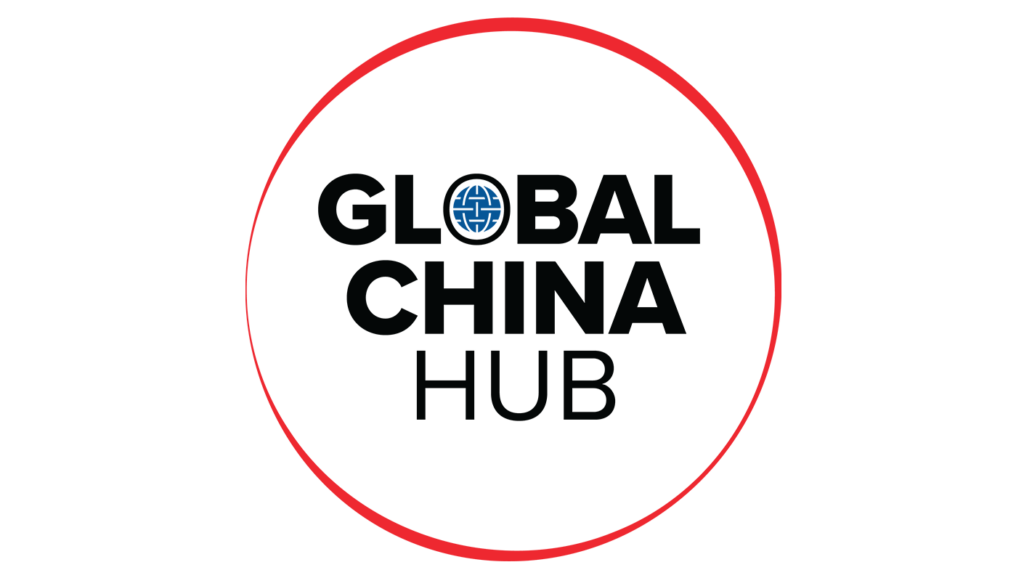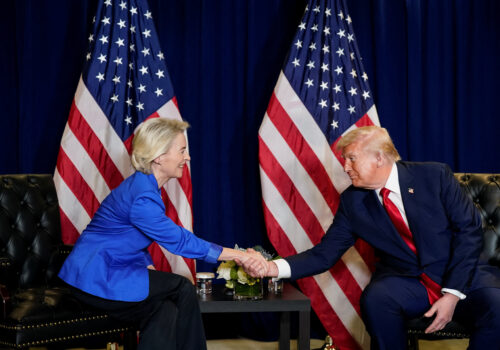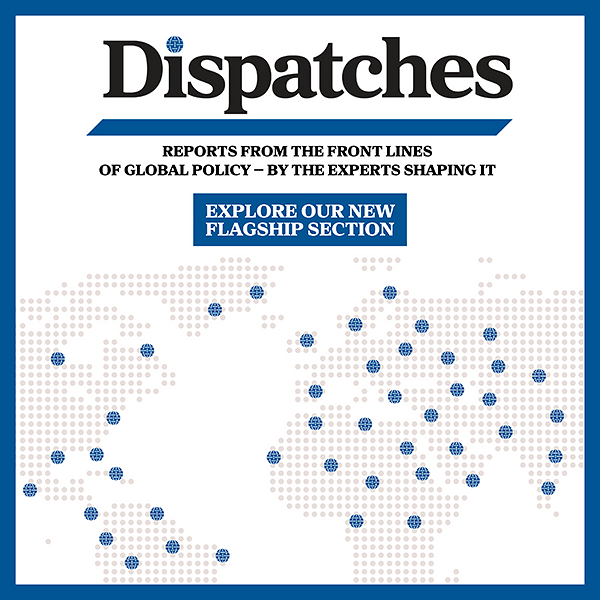How Europe deals with China in trade, technology, and security
This is the twelfth chapter of the report “Is Europe waking up to the China challenge? How geopolitics are reshaping EU and transatlantic strategy.” Read the full report here.
After several decades of trying to build a cooperative trade and political relationship with China, the EU came to recognize that this engagement strategy delivered limited economic gains while creating political tensions that ran counter to its own values and objectives. By 2019, optimism had given way to a new perception of China as partner, competitor, and systemic rival. This threefold framing—contradictory in theory but politically useful in practice—created enough ambiguity and common ground to allow maneuvering among member states with divergent priorities. At the same time, it provided a platform for a broader debate about Europe’s China policy.
Countries such as Greece, Italy, Portugal, and Hungary, which received significant Chinese investment in the aftermath of the Eurozone crisis, were able to proceed cautiously, avoiding confrontational language that could have had negative economic consequences. By contrast, northern and Baltic states favored a tougher approach, emphasizing the systemic-rival framing. France and Germany were internally divided but ultimately supported the EU policy, with France leaning toward a tougher line on trade and sovereignty and Germany under Chancellor Angela Merkel continuing to prioritize engagement. The European Council’s delayed endorsement of the triptych of cooperation, economic competition, and systemic rivalry in June 2023—four years after the European Commission had introduced this framing—highlighted Europe’s initial reluctance to acknowledge problems in EU-China economic relations. Ultimately, however, member states paved the way for gradual convergence on a common China policy.1“European Council Meeting (29 and 30 June 2023)—Conclusions,” European Council, June 30, 2023, https://data.consilium.europa.eu/doc/document/ST-7-2023-INIT/en/pdf. By 2023, the EU recognized that the risks of engaging with China had begun to outweigh the benefits.
Because the EU is not a unitary actor, its China policy reflects the diverse relationships, preferences, vulnerabilities, and strategic cultures of its member states. Case studies of Germany, France, Italy, Greece, Hungary, Poland, Lithuania, and the Czech Republic underscore the complexity of EU-China relations and demonstrate how national trajectories shape or constrain Brussels’ evolving China strategy. France and Germany serve as the EU’s strategic anchors, with Paris emphasizing sovereignty and resilience and Berlin shifting from economic primacy toward a more strategic-industrial approach. Italy and Greece exemplify cautious strategic recalibration: once open to Chinese investment and the Belt and Road Initiative (BRI), both now cautiously align with Brussels while preserving economic ties with Beijing. Meanwhile, Poland has moved from economic pragmatism to security awareness as limited trade benefits and Beijing’s alignment with Moscow eroded earlier optimism; the Czech Republic maintains a values-based approach, combining minimal trade exposure with one of the EU’s strictest investment-screening regimes; and Lithuania has emerged as a catalyst, translating bilateral confrontation into EU-wide resilience and transatlantic coordination. Hungary, by contrast, continues to act as a spoiler, deepening ties with Beijing and using its veto power to undermine EU unity.
Trade and investment: Between open markets and strategic control
Although trade and investment form the backbone of Europe’s relationship with China, they are also a principal source of friction. At the EU level, the tendency to favor “de-risking, not decoupling” may be too soft an approach to secure desirable trade flows while reducing strategic dependencies. Although this approach has spurred the rollout of the EU’s investment-screening mechanism, initiated anti-subsidy investigations into Chinese electric vehicles (EVs) and solar panels, and resulted in the freezing of the Comprehensive Agreement on Investment, it remains unclear whether these measures will suffice to counter Chinese influence.
Germany has historically been the most influential actor in shaping the EU’s China policy, especially in trade, and its globalization-driven economy—long tied to China in automobiles, machinery, and chemicals—faced the highest potential gains and risks. Under Chancellor Friedrich Merz, Berlin has abandoned partnership language and aligned more closely with Brussels’ emphasis on rivalry and critical-infrastructure protection. However, divisions within the German business sector continue to complicate policy coherence, and Merz has yet to demonstrate through action his intent to advance the EU’s agenda. Meanwhile, France has consistently pushed for stronger EU trade defenses and long advocated an assertive industrial policy to counter China’s overcapacity. Under President Emmanuel Macron, Paris pressed the European Commission to launch anti-dumping investigations into Chinese EVs in 2023.
Italy’s China stance has shifted from opportunistic engagement to closer EU alignment. Its decision to join the BRI in 2019 was emblematic of its short-term, partisan-driven policymaking aimed at quick economic gains. By December 2023, however, Rome withdrew from the BRI and strengthened its “golden power” rules, signaling broad skepticism toward China and Prime Minister Giorgia Meloni’s commitment to transatlantic cooperation—while still seeking to preserve economic opportunities. Similarly, Greece’s trajectory is one of gradual adjustment. In the aftermath of its debt crisis, Athens relied heavily on Chinese capital, most prominently through China COSCO Shipping Corporation Limited’s ownership of the port of Piraeus. Since 2020, diversification of foreign direct investment (FDI) and pressure from the EU and the United States have tempered Athens’ dependence on Beijing. Greece’s adoption of the EU’s FDI-screening mechanism, combined with its abstention from EU tariffs on Chinese EVs in October 2024, illustrates its hedging strategy.
Lithuania presents a strikingly different case. With little bilateral trade at stake, Vilnius has taken one of the EU’s toughest stances on China, portraying it as a coercive power and systemic rival. Its confrontation with Beijing over Taiwan in 2021 triggered Chinese retaliation but also accelerated Brussels’ adoption of the Anti-Coercion Instrument. Lithuania thus transformed a bilateral dispute into a catalyst for EU-wide resilience, reframing trade and investment policy as a question of collective security rather than purely economics.
For years, Poland prioritized economic ties with China over national security, even though—as elsewhere in Europe—trade and investment flows never fully materialized, leaving Warsaw with a significant trade deficit. However, China’s support for Russia’s war in Ukraine has eroded Warsaw’s desire for partnership. By 2020, Poland was ahead of the EU curve in creating an FDI-screening mechanism, though implementation has lagged. Meanwhile, the Czech Republic has maintained a values‑driven, security‑first approach to China. Rather than chasing short-term economic gains, Prague has developed one of the region’s most robust economic‑security frameworks, anchored by the 2021 Foreign Investment Screening Act.
Hungary stands alone in its defiance of EU norms, having consistently courted Chinese trade and investment while resisting EU restrictions. Prime Minister Viktor Orbán has denounced EU tariffs as an “economic cold war”—and Budapest’s willingness to openly align with Beijing has provided China with an important foothold within the EU.
Technology: Building resilience in the digital era
Technology has emerged as the sharpest arena of competition with China, encompassing 5G infrastructure, semiconductors, artificial intelligence, and dual-use goods. The EU response includes the 5G toolbox, tighter export controls, and coordination with the United States on technology governance, though the pace and scope of implementation vary widely across member states.
As in other sectors, Germany displays ambivalence toward China in technology. While its Foreign Trade and Payments Act—together with its implementing regulation, the Foreign Trade and Payments Ordinance—provides one of Europe’s strictest foreign-investment screening regimes, with a broad scope of sectors covered and low thresholds for review, implementation has at times lagged behind its rhetoric. Berlin was slow to curb Huawei and ZTE’s role in 5G networks, prioritizing industrial competitiveness and cost concerns. Only in July 2024 did the German government announce a full phase-out, aligning with EU and NATO partners. France, by contrast, has been the EU’s leading driver in technology policy, framing digital resilience as both an economic concern and a geopolitical imperative. Paris has consistently pressed for stronger protection of European innovation, critical infrastructure, and strategic industries, embedding technological sovereignty at the heart of Europe’s pursuit of strategic autonomy.
Similarly, Italy’s “golden power” rules have increasingly restricted Chinese participation in telecommunications and infrastructure. While Italian policy is often reactive, it has aligned more closely with Brussels on tech resilience. Greece, in turn, has moved toward the EU mainstream more gradually, even if its enforcement capacity remains weaker than in northern Europe. Athens noticeably shifted course in 2020, when its largest telecommunications operator chose Swedish multinational Ericsson over Huawei, signaling a symbolic alignment with Western preferences.
Hungary, in a pattern mirroring its approach on trade and investment, remains a holdout, deepening digital cooperation with Beijing by welcoming Huawei investment in direct contradiction to EU guidance. This divergence underscores Budapest’s role as a spoiler, slowing EU cohesion on technology. By contrast, Lithuania has taken a markedly different path, pushing for strong restrictions on Huawei and championing EU-level tech screening. Despite its small size, its alignment with US standards reflects its values-driven foreign policy and reinforces its role as a policy innovator.
Poland allowed Chinese companies a significant presence in its telecommunications sector until 2020. However, a series of events—including a Huawei employee’s arrest for espionage, US pressure, and the EU’s adoption of its 5G Toolbox—eventually pushed Warsaw to diversify the sector and reduce Huawei’s and ZTE’s activities to the bare minimum. Meanwhile, Czechia has pursued a proactive, risk-based approach to technology policy. Ahead of the introduction of the EU’s 5G Toolbox, the Czech National Cyber and Information Security Agency flagged Huawei and ZTE as high-risk actors, paving the way for sector diversification. Prague aligns with US efforts on 5G security and export controls and has deepened ties with Taiwan, Japan, and South Korea on semiconductors and advanced manufacturing, while curbing exposure to China-linked supply chains.
Security: Turning awareness into action
Security is the area in which China has most clearly been recast as a systemic rival, particularly since the announcement of its “no limits” partnership with Russia. Although China is officially defined as a systemic rival, few tangible measures have been adopted to operationalize this stance. The EU has tightened export controls, reinforced NATO coordination, and cautiously expanded its Indo-Pacific engagement. Member states’ responses again diverge, shaped by geography, threat perceptions, and alliance politics.
Germany’s security stance has evolved markedly. Under Merkel, Berlin downplayed concerns about Taiwan, the South China Sea, and Chinese alignment with Moscow. Under Olaf Scholz, it cautiously endorsed de-risking and adopted tougher rhetoric. Today, under Chancellor Friedrich Merz, Berlin has moved even further, dropping “partnership” language and framing China as part of an “axis of autocracies.” Still, economic dependence tempers full securitization. France, by contrast, has long promoted Europe’s role as a global security actor. It backs EU sanctions against Beijing for its support of Russia, deploys forces in the Indo-Pacific, and seeks partnerships with democracies in the region. Its approach fuses European sovereignty with transatlantic coordination, framing security in comprehensive geopolitical terms.
Italy’s posture is more cautious. NATO engagement has reinforced Rome’s limits on Chinese access to critical infrastructure, and the war in Ukraine has hardened its stance against Russia. Yet Italy avoids labeling China as a direct security threat, signaling solidarity in Indo-Pacific deployments without projecting power. Greece, in turn, interprets security primarily through a regional lens. Anchored in NATO and reliant on US guarantees amid tensions with Turkey, Athens avoids sharp rhetoric on China but complies with EU export controls and acknowledges risks in dual-use technologies. Here, resilience is understood more in economic than military terms.
Meanwhile, Hungary actively undermines EU security cohesion by blocking joint statements on Hong Kong, Xinjiang, and Taiwan, and by opposing broader de-risking. Its alignment with Beijing—especially during its 2024 presidency of the Council of the European Union—highlighted the risks of internal veto power in weakening collective security signaling. By contrast, Lithuania has been a catalyst for collective resilience. Its confrontation with China over the opening of a Taiwanese representative office in Vilnius, and Beijing’s ensuing de facto trade embargo, made Chinese coercion a European security issue. For Vilnius, China policy is inseparable from its existential confrontation with Russia, casting Beijing and Moscow as dual pillars of an authoritarian bloc.
The paramount and inescapable issue overriding all other issues is Russia’s war on Ukraine—and Beijing’s support for Moscow. While a shared concern of enormous gravity to all, it has had an acute effect on Central and Eastern European states, shifting their perspectives from an economics‑first toward a security-driven China policy. In Poland, this has meant tightening alignment with the United States, curtailing high‑exposure ties, and urging Beijing to end dual‑use exports that could aid Russia. Czechia, in turn, has taken a proactive stance, viewing China as a systemic challenge to European and transatlantic security. Taiwan remains central to Prague’s engagement in Asia, with cooperation in semiconductors and industry, while intelligence and public institutions consistently flag China as a source of foreign influence and espionage.
About the authors
Related Content
Explore the programs

The Global China Hub tracks Beijing’s actions and their global impacts, assessing China’s rise from multiple angles and identifying emerging China policy challenges. The Hub leverages its network of China experts around the world to generate actionable recommendations for policymakers in Washington and beyond.

The Europe Center promotes leadership, strategies, and analysis to ensure a strong, ambitious, and forward-looking transatlantic relationship.
Image: The European Quarter in Brussels, Belgium, on July 30, 2023, features EU flags waving in the foreground, the modern glass architecture of the area, and the striking 'The Future is Europe' vision on a building in the background. Painted in blue tones, it symbolizes European unity and progress. The surrounding buildings include the Berlaymont, headquarters of the European Commission, and other key EU institutions. (Photo by Michael Nguyen/NurPhoto)NO USE FRANCE




